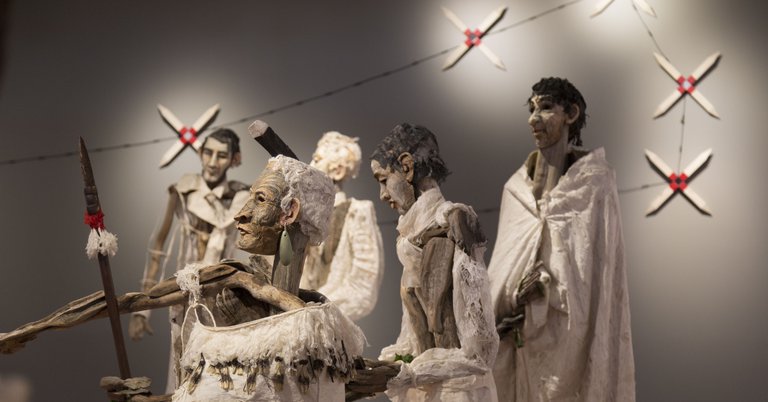


Just some of the lifelike sculptures that make up- the Pale History exhibition
An exhibition commemorating a fatal battle over land rights between Ngāti Toa Rangatira and European settlers is coming to Pātaka Gallery + Museum this December.
The Pale History collection tells the story of the Wairau Incident, when Ngāti Toa chief Te Rauparaha and his followers faced off in a violent confrontation in 1843 that led to the loss of 26 lives.
The exhibition is just one of a host of new shows which get underway as part of the Pātaka’s new season on December 16.
The incident, on 17 June, came in the wake of the signing of the Treaty of Waitangi in 1840, and forever changed relationships between Māori and settlers in New Zealand.
Pātaka Contemporary Art Curator Mark Hutchins-Pond said Nelson artist Sally Burton had commemorated the incident by making life-size wooden figures out of driftwood gathered from rivers near where it took place, draped in traditional South Pacific tapa cloth.
Hutchins-Pond said Burton’s interest in the confrontation came from her living on a road named after the land surveyor whose actions were the unfortunate cause of the incident.
“Sally Burton lives on Cottrell Road, named after land surveyor John Cottrell, who was a 23-year old pacifist and Quaker given the task of seeing if the land at Wairau was suitable for farming and settlement.
“The New Zealand company tasked Cottrell with surveying the area, having claimed it had bought the land as part of purchases made from Cook Strait Maori in 1839.
“However Te Rauparaha and his nephew, Te Rangihaeata, a chief in his own right, disputed this land purchase and so carefully removed Cottrell’s surveying equipment which was paddled back to the settlers ship in Cloudy Bay, before he and his followers burned down the surveyors shelters and huts.”
When the New Zealand Company reached the area, Cottrell laid a complaint of arson against Te Rauparaha and his brother. A group of settlers gathered a militia to arrest the Māori chief, a decision that would ultimately lead to the fatal incident, Hutchins-Pond said.
“Te Rauparaha and Te Rangihaeata went to Wairau to meet with the settlers and resolve the matter peacefully. It was only when a shot fired by someone in the Nelson militia killed Te Rangihaeata’s wife that Ngāti Toa violently retaliated.
“This event is a key moment in New Zealand’s history and in the history of our iwi here in Porirua, the affects of which are still being felt across the country today.
“It’s therefore a privilege to be able to host this exhibition, which will help inform and educate locals and visitor about the tribe’s history, and the part Te Rauparaha played in fighting for the land rights of his people and fellow Māori.”
Hutchins-Pond said Burton’s name for the exhibition, Pale History, is inspired by the fact that the version of history we are told is often a paler, biased version of reality, with actual events often being more confusing, messy and uncontainable.
“Burton provides a more stark vision of the reality of our Pale History”, Hutchins-Pond said.
7 Nov 2018